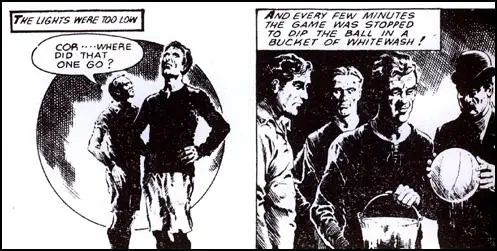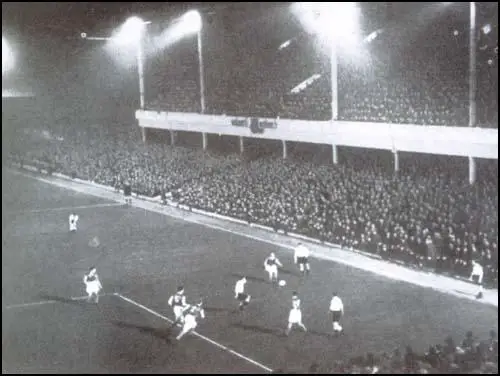Floodlit Football
The first experiments with playing football games with artificial lighting began in October 1878 at Bramall Lane, Sheffield. The lamps were mounted on timber gantries and powered by dynamo machines powered by batteries or steam engines. Over the next few years several floodlit friendly games took place but the technology was very unreliable and sometimes the match had to be abandoned.
On 4th November 1878 Blackburn Rovers played its first floodlit game. As Mike Jackman has pointed out in his book, Blackburn Rovers: An Illustrated History (1995): "The visitors were Accrington and the ground was illuminated by the Gramme light - one being situated at the east end of the Meadows and the other at the west end. Each light was attached to a scaffold that rose some 30 to 40ft from the ground. An 8hp portable engine was required to work the battery and it was said that the system provided the equivalent of some 6,000 candle power. However, it was felt necessary to paint the ball white to aid both players and spectators."
The clubs continued to experiment for financial reasons. In the 19th century, because of religious reasons and the five and a half week, it was only possible to play football games on a Saturday afternoon. The directors of the clubs realised that they could increase revenue if they could arrange games to be played under artificial light during weekday evenings.
In 1885 it was decided by the Football Association that clubs could play professionals in the FA Cup competition. It was not long before football clubs had large wage bills to play. It was therefore necessary to arrange more matches that could be played in front of large crowds. In March, 1888 it was suggested that "ten or twelve of the most prominent clubs in England combine to arrange home and away fixtures each season."
The following month the Football League was formed. It consisted of six clubs from Lancashire (Accrington, Blackburn Rovers, Burnley, Everton and Preston North End) and six from the Midlands (Aston Villa, Derby County, Notts County, Stoke, West Bromwich Albion and Wolverhampton Wanders).
The first league competition took place in 1888-89. As it was considered important that all league games should be completed successfully, it was decided to ban the playing of floodlit games.
Non-league clubs continued to experiment with floodlit games. In 1895, Arnold Hills, the owner of the Thames Ironworks Shipbuilding Company in Canning Town, decided to form his own club. That season, Thames Ironworks (the club's name was changed to West Ham United in 1900) played several floodlit games.
The West Ham Herald reported that Hills wanted to discover "who are prevented through their daily avocation from attending afternoon matches by carrying out those by the aid of electric light on the ground at Canning Town".
The first night match took place on 16th December, 1895. The pitch was surrounded by light bulbs attached to poles. The football was dipped in pails of whitewash to make it easier to see. As one observer pointed out, the "enamelled white" football "showed up well in the bluish haze of the electric light".

Arnold Hills was informed that the generator "met the requirements and worked well" and "ten lights each of 2,000 candle power gave a good view to those present". One local newspaper reported that floodlit football "has certainly taken root judging by the big crowd that paid at the gate last evening to witness the contest".
Their fourth floodlit game was against Barking Woodville. In his book, Iron in the Blood, John Powles quotes a report in the West Ham Herald: "Boys were swarming up over the fences for a free view when I put in an appearance. And what a smart man the Ironworkers have at the gate. He seemed to think my ticket was a real fraud until he had turned it upside down and inside out, and smelled at it for a considerable time. But he graciously passed me at last." The Irons won 6-2 with Charlie Dove getting a hat-trick.
The club decided to arrange two floodlit games against clubs in the Football League. The club committee arranged for the erection of canvas screens round the moat-ringed pitch so they could charge the public for watching the game. On Monday, 16th March, the works club lost 5-3 to Arsenal. The game was watched by 2,000 spectators. On the Friday night of that week they were defeated 4-2 by the mighty West Bromwich Albion.
When West Ham United joined the Southern League in 1898-99 season, they also stopped playing football under artificial light.
During the First World War women's football became very popular. These games were played to raise money for charity. The best team in England was Dick Kerr's Ladies. In 1920 Alfred Frankland, the manager of this team, was informed that the local charity for Unemployed Ex Servicemen was in great need for money to buy food for former soldiers for Christmas. Frankland decided to arrange a game between Dick Kerr Ladies and a team made up of the rest of England. Deepdale, the home of Preston North End was the venue. To maximize the crowd, it was decided to make it a night game. Permission was granted by the Secretary of State for War, Winston Churchill, for two anti-aircraft searchlights, generation equipment and forty carbide flares, to be used to floodlight the game.
Over 12,000 people came to watch the match that took place on 16th December, 1920. It was also filmed by Pathe News. Bob Holmes, a member of the Preston team that won the first Football League title in 1888-89, had the responsibility of providing whitewashed balls at regular intervals. Although one of the searchlights went out briefly on two occasions, the players coped well with the conditions. Dick Kerr Ladies showed they were the best woman's team in England by winning 4-0. Jennie Harris scored twice in the first half and Florrie Redford and Minnie Lyons added further goals before the end of the game. As a result of this game, the Unemployed Ex Servicemens Distress Fund received over £600 to help the people of Preston. This was equivalent to £125,000 in today's money.
Soon afterwards the Football Association banned member clubs of the Football League from allowing women teams to use their grounds for football matches. Once again, floodlit football came to an end.
During the 1930s, Herbert Chapman, the manager of Arsenal, arranged for floodlights to be built into the West Stand but the Football Association and the Football League refused permission for the club to use them for official matches. Bob Wall later wrote: "Chapman thought deeply about an infinite variety of subjects associated with the game. He possessed the gift of seeing ahead of his time. He was able to visualize how soccer could benefit from adopting ideas which, in their infancy, seemed to most other people to be merely the outpourings of an eccentric mind."
The FA refused and it was not until after the Second World War that the issue was raised again. In the early 1950s clubs like Wolverhampton Wanders played friendlies under lights against some of Europe's leading teams. These games attracted large crowds and the authorities eventually withdrew their objections. The first league game under floodlights took place in 1956 between Portsmouth and Newcastle United.

West Ham beat Tottenham Hotspur 2-1.
